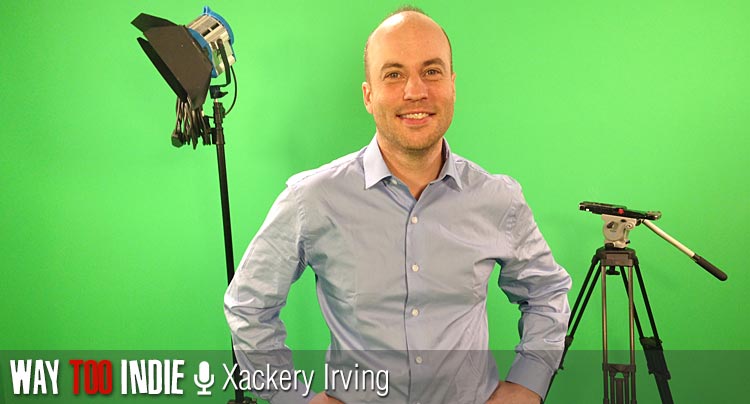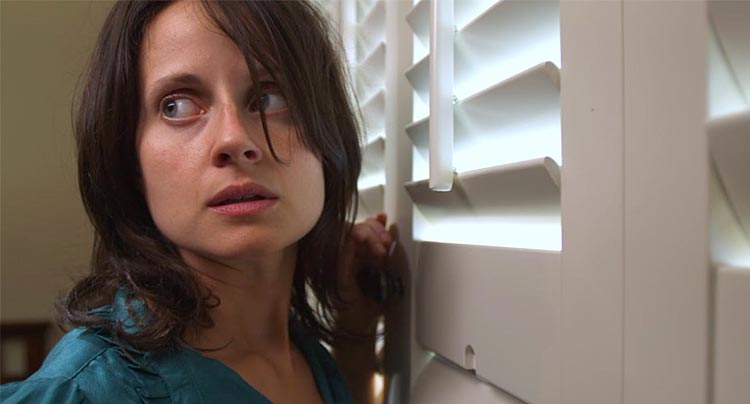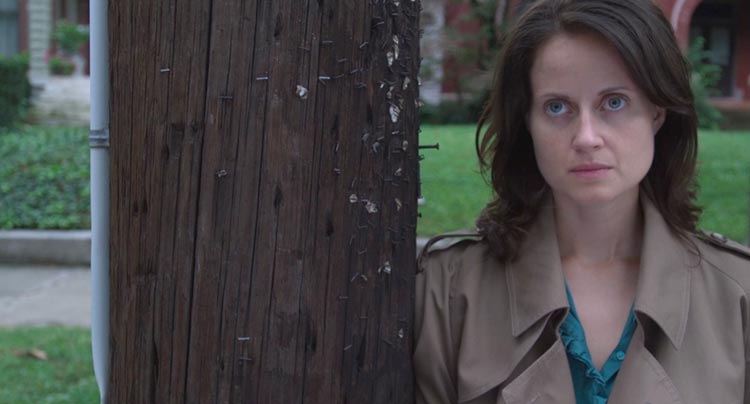Xackery Irving Explains the Benefits of a Small Crew in ‘Nothing Without You’

Having won an award for Best Feature in their budget category at the Toronto Independent Film Festival, director Xackery Irving proves in his latest film Nothing Without You that you do not have to sacrifice production value because of a small budget. This indie thriller is about a delusional woman who is the prime suspect of a murder. Put in the same position as her psychiatrist, we must decide if she is telling the truth or if her perception of reality is getting the best of her.
Xackery talks in-depth about the benefits of having a small crew, the importance of sound design in film, playing at various film festivals, and much more.
Listen to the interview
Special thanks to @PaulSchipper for editing audio of our interview
Can you talk about some of the film festivals you have already attended?
We started at the Toronto Independent Film Festival, which runs at the same time as TIFF (Toronto International Film Festival). We premiered there and we won Best Feature for our budget category. It was great to start with a win and it got us good press. Then we got to a smaller festival with a great reputation and a curated roster of films at the Santa Fe Film Festival. We were playing with films that were shortlisted for Oscar nominations, so that was humbling. We also played at the Sarasota Film Festival.
You mentioned budget, considering the limited budget of under $200,000 total, what were some of the shortcuts that you had to take because of the budget?
So it was a lot. We didn’t ever want to sacrifice production value. We also wanted to make sure we hired a competent crew and post-production staff. There are certain corners that you cannot cut. My background is that I went to film school where we used 16mm and 35mm film, [so] I decided to operate camera and shoot it myself. And that allowed a lot of flexibility and a smaller footprint and a better use of our time.
You have a lot of credits; writing, directorial, cinematography, even producer. So you had your hand in a lot of aspects in the film.
Yeah, it was grueling. And I think a lot of filmmakers are doing that in the independent scene now. A lot of them are editing their own films. One of the things about shooting the film myself, was a huge advantage not just in getting things done quickly, [but] having one less conversation with a director of photography, for me was the right way to go.
My favorite aspect of Nothing Without You is the cinematography. In particular, there were some interesting shots of her [Emily] hiding underneath the bed that produced a lot of great suspense. But one shot that really stood out to me the most was the snow falling. What kind of equipment were you using to capture that beautiful scene?
So I was in Louisville doing principal photography and we shot in the fall. I drove up to New York by way of my home state of West Virginia. I knew I wanted that shot, I knew I wanted there to be a lot of snow. Fortunately, there was a lot of snow [because] there was a huge blizzard. So I timed it so I could hit that exterior.
I just had a RED One camera in the trunk [and] I used Nikon lenses. Shot a lot of angles. Because of the rough cut was thrown together, I knew exactly what kind of shot sequence I was going for. So it was good timing and the flexibility of having your own camera.
That is kind of amazing that you just had that in your trunk!
(laughs) It was a little scary pulling over to get gas and things.
Was the whole film shot on RED then?
It was all shot on RED. I love the RED.

As a director was this your first time working with digital film? You mentioned you worked a lot in the past with 16mm.
My first film was a documentary called American Chain Gang. I shot that on 16mm. So my background is documentary filmmaking and also documentary television. So a lot of the shows that I would produce, I would also shoot. These would be [shot on] small three-chip tapes on digital format cameras. Nothing like the RED, but [it was] broadcast resolution. So that gave me a lot of confidence to shoot a more ambitious narrative project.
Aside from the cinematography, the overall story is very suspenseful and the narration always stays one step behind the characters so that always keeps the audience guessing. Were all those twists in the script or did some of them come after the fact?
What Rick [co-writer and producer] and I would do when we were developing this story is we would come up with a lot of “what-ifs”. Rick came up with the big plot twists (which I won’t mention because I want people to see it).
In addition to that, we had direction [from] a friend of mine Keir Pearson, who wrote his first screenplay out of the gate [was] Hotel Rwanda (it was nominated for an Oscar). So whenever he had some suggestions or direction for us, we listened.
If you watch the film a second time you can see how voiceover is used as sort of a precursor to the beginning of a conversation with a character you’ll see on camera. What we wanted to do is establish a day-in-the-life of a character what is maybe hard for us to relate to because she is a stalker. She is maybe someone who is capable of a lot of violence and some who may not be sympathetic.
Yeah, there are a lot of voiceovers in the beginning like you mentioned. Her first on-screen word is about 5 minutes in. So she had to convey a lot without the use of dialog.
Right.
One of my favorite scenes is when she escapes from the hospital to call Michael and the cops are thought to be sent to her location, but she actually leads them elsewhere.
Well one of the things that I was discussing with Rick and Keir, is the way everyone was sort of seeing her emerge in early drafts as she might be crazy. But she’s really, really smart. And that was important to convey because her issue of her experience with reality is always in question. But if she is one-step ahead of police, of people who are afraid of her, or [people] manipulating her, then that’s another aspect that makes us relate and like the character.
Right. Because she does some very incriminating things in order to prove her innocence. Her character is almost difficult to trust at times.
Yeah. That is the point. At the center of the film, is a relationship with her court-appointed psychiatrist whose hired to prove that she is crazy. And you are supposed to question it.
Part of the character of Charley, her doctor, does for us is sort of grounds us in reality. We can sometimes see her behavior through his perspective, one step behind by the way.

What do you think Jennifer’s future is at the end? Do you believe all that she ends up doing would go un-penalized?
I’m going to be very vague about that because I don’t want anyone to know what happens at the end, I can just say that there [is] more than one big twist. But I wanted to have the final lines of the film open up maybe an even deeper connection with a character that has gone through a great deal, and everyone around her has gone through a great deal.
Early on Jennifer notices her doctor Charles’ ring, what was the significance of Claudia (Charles’ wife) to the story?
We needed something for Charlie to see in Jennifer, maybe on a subconscious level, that would explain why he goes so deep in helping her and putting himself in such a vulnerable position.
There is a scene where he sees Claudia and Emily [who plays Jennifer] in the same location. So that is part of understand his character and his motivation.
And she [Jennifer] ends up wearing some of her [Claudia] clothes even.
That’s right. Its an other instance where she’s putting on a role of someone.
You got Victoria de la Vega to produce a fantastic score for the film. It really gave it a great sense of suspense. Could you talk about how getting her onboard with this project?
Yeah. It was vital to have the right composer and our mixer David Wilson (who I know from some TV work). He said to Victoria when they met; music might be King, but sound is Queen. So they work very closely. Sound design is vital to building suspense.
Victoria came to us [by] approaching NYU’s graduate film scoring program. Victoria gave us spec track that she did for us and we really enjoyed what she had done and chose to work with her. What she did is she used a lot of themes and her progression using minor 5ths and having a bowed guitar gave the sense of the melancholy wistfulness for these characters. And certainly accelerated and underscored some of the emotional tension.
We have this character [that] is this perennial patient who is always showing up and she used a glockenspiel. Which works well with the rest of the music, it just sort of pierces through it. So she did an amazing job and we will be releasing the score on iTunes very soon.
Victoria now works with Hans Zimmer and worked closely with him on the soundtrack for 12 Years A Slave.
Do you have any other projects in the works?
Yeah, so working on a lot of TV work. And working on developing a new project that has a lot of similar qualities [to Nothing Without You]. It’s a little darker; [it has a] female lead and a psychological thriller. The working title is The Skin Diver, and having fun writing it.
